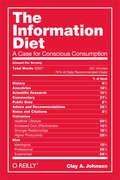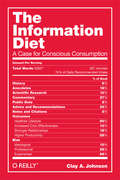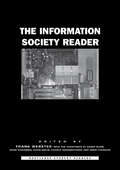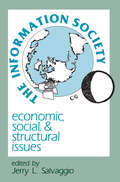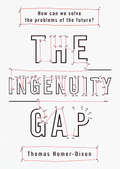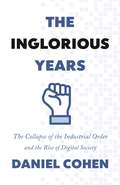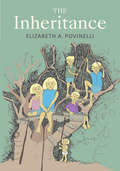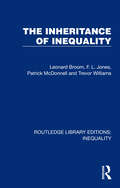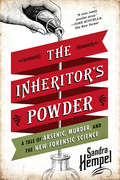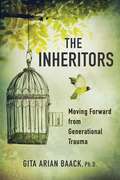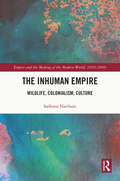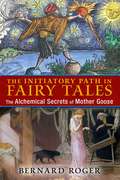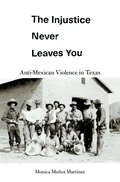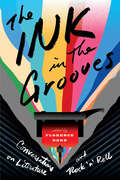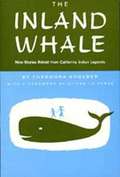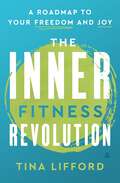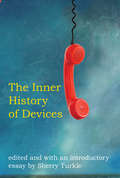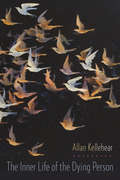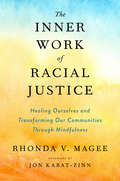- Table View
- List View
The Information Diet: A Case for Conscious Comsumption
by Clay A. JohnsonThis is a softcover version of the title released in 2011; there is no new material.The modern human animal spends upwards of 11 hours out of every 24 in a state of constant consumption. Not eating, but gorging on information ceaselessly spewed from the screens and speakers we hold dear. Just as we have grown morbidly obese on sugar, fat, and flour—so, too, have we become gluttons for texts, instant messages, emails, RSS feeds, downloads, videos, status updates, and tweets.We're all battling a storm of distractions, buffeted with notifications and tempted by tasty tidbits of information. And just as too much junk food can lead to obesity, too much junk information can lead to cluelessness. The Information Diet shows you how to thrive in this information glut—what to look for, what to avoid, and how to be selective. In the process, author Clay Johnson explains the role information has played throughout history, and why following his prescribed diet is essential for everyone who strives to be smart, productive, and sane.In The Information Diet, you will:Discover why eminent scholars are worried about our state of attention and general intelligenceExamine how today’s media—Big Info—give us exactly what we want: content that confirms our beliefsLearn to take steps to develop data literacy, attention fitness, and a healthy sense of humorBecome engaged in the economics of information by learning how to reward good information providersJust like a normal, healthy food diet, The Information Diet is not about consuming less—it’s about finding a healthy balance that works for you
The Information Diet: A Case for Conscious Consumption
by Clay A. JohnsonThe modern human animal spends upwards of 11 hours out of every 24 in a state of constant consumption. Not eating, but gorging on information ceaselessly spewed from the screens and speakers we hold dear. Just as we have grown morbidly obese on sugar, fat, and flour—so, too, have we become gluttons for texts, instant messages, emails, RSS feeds, downloads, videos, status updates, and tweets.We're all battling a storm of distractions, buffeted with notifications and tempted by tasty tidbits of information. And just as too much junk food can lead to obesity, too much junk information can lead to cluelessness. The Information Diet shows you how to thrive in this information glut—what to look for, what to avoid, and how to be selective. In the process, author Clay Johnson explains the role information has played throughout history, and why following his prescribed diet is essential for everyone who strives to be smart, productive, and sane.In The Information Diet, you will:Discover why eminent scholars are worried about our state of attention and general intelligenceExamine how today’s media—Big Info—give us exactly what we want: content that confirms our beliefsLearn to take steps to develop data literacy, attention fitness, and a healthy sense of humorBecome engaged in the economics of information by learning how to reward good information providersJust like a normal, healthy food diet, The Information Diet is not about consuming less—it’s about finding a healthy balance that works for you
The Information Society Reader (Routledge Student Readers)
by Frank WebsterThere has been much debate over the idea of 'the information society'. Some thinkers have argued that information is becoming the key ordering principle in society, whereas others suggest that the rise of information has been overstated. Whatever the case, it cannot be denied that 'informization' has produced vast changes in advanced societies. The Information Society Reader pulls together the main contributions to this debate from some of the key figures in the field. Major topics addressed include:* post-industrialism* surveillance* transformations* the network society* democracy* digital divisions* virtual relations.With a comprehensive introduction from Frank Webster, selections from Manuel Castells, Anthony Giddens, Michel Foucault and Christopher Lasch amongst others, and section introductions contextualising the readings, this book will be an invaluable resource for students and academics studying contemporary society and all things cyber.
The Information Society: Economic, Social, and Structural Issues (Routledge Communication Series)
by Jerry L. SalvaggioFirst Published in 1989. Routledge is an imprint of Taylor & Francis, an informa company.
The Information Trade: How Big Tech Conquers Countries, Challenges Our Rights, and Transforms Our World
by Alexis Wichowski"A timely, compelling, and expertly researched passport to the tech companies that rule today's digital landscape."—Blake Harris, bestselling author of Console Wars and The History of the Future.In this provocative book about our new tech-based reality, political insider and tech expert Alexis Wichowski considers the unchecked rise of tech giants like Facebook, Google, Amazon, Apple, Microsoft, and Tesla—what she calls “net states”— and their unavoidable influence in our lives. Rivaling nation states in power and capital, today’s net states are reaching into our physical world, inserting digital services into our lived environments in ways both unseen and, at times, unknown to us. They are transforming the way the world works, putting our rights up for grabs, from personal privacy to national security. Combining original reporting and insights drawn from more than 100 interviews with technology and government insiders, including Microsoft president Brad Smith, Google CEO Eric Schmidt, the former Federal Trade Commission chair under President Obama, and the managing director of Jigsaw—Google’s Department of Counter-terrorism against extremism and cyber-attacks—The Information Trade explores what happens we give up our personal freedom and individual autonomy in exchange for an easy, plugged-in existence, and shows what we can do to control our relationship with net states before they irreversibly change our future.
The Ingenuity Gap: Can We Solve The Problems Of The Future?
by Thomas Homer-Dixon"The most persuasive forecast of the 21st century I have seen. " -- E. O. Wilson, author ofConsilience: The Unity of Knowledgeand twice winner of a Pulitzer prize “Human beings have been smart enough to turn nature to their ends, generate vast wealth for themselves, and double their average life span. But are they smart enough to solve the problems of the 21st century?” --Thomas Homer-Dixon Can we create ideas fast enough to solve the very problems -- environmental, social, and technological -- we’ve created? Homer-Dixon pinpoints the “ingenuity gap” as the critical problem we face today, and tackles it in a riveting, groundbreaking examination of a world that is rapidly exceeding our intellectual grasp. InThe Ingenuity Gap, Thomas Homer-Dixon, "global guru" (theToronto Star), "genuine academic celebrity" (Saturday Night) and "one of Canada's most talked about and controversial scholars" (Maclean's) asks: is our world becoming too complex, too fast-paced to manage? The challenges facing us -- ranging from international financial crises and global climate change to pandemics of tuberculosis and AIDS- converge, intertwine, and remain largely beyond our ken. Most of suspect the "experts don't really know what's going on; that as a species we've released forces that are neither managed nor manageable. We are fast approaching a time when we may no longer be able to control a world that increasingly exceeds our grasp. This is "the ingenuity gap" -- the term coined by Thomas Homer-Dixon, political scientist and advisor to the White House -- the critical gap between our need for practical, innovative ideas to solve complex problems and our actual supply of those ideas. Through gripping narrative stories and incidents that exemplify his arguments, he takes us on a world tour that begins with a heartstopping description of the tragic crash of United Airlines Flight 232 from Denver to Chicago and includes Las Vegas in its desert, a wilderness beach in British Columbia, and his solitary search for a little girl in Patna, India. He shows how, in our complex world, while poor countries are particularly vulnerable to ingenuity gaps, our own rich countries are not immune, and we are caught dangerously between a soaring requirement for ingenuity and an increasingly uncertain supply. When the gap widens, political disintegration and violent upheaval can result, reaching into our own economies and daily lives in subtle ways. In compelling, lucid, prose, he makes real the problems we face and suggests how we might overcome them -- in our own lives, our thing, our business and our societies. From the Trade Paperback edition.
The Inglorious Years: The Collapse of the Industrial Order and the Rise of Digital Society
by Daniel CohenHow populism is fueled by the demise of the industrial order and the emergence of a new digital society ruled by algorithmsIn the revolutionary excitement of the 1960s, young people around the world called for a radical shift away from the old industrial order, imagining a future of technological liberation and unfettered prosperity. Industrial society did collapse, and a digital economy has risen to take its place, yet many are left feeling marginalized and deprived of the possibility of a better life. The Inglorious Years explores the many ways we have been let down by the rising tide of technology, showing how our new interconnectivity is not fulfilling its promise.In this revelatory book, economist Daniel Cohen describes how today's postindustrial society is transforming us all into sequences of data that can be manipulated by algorithms from anywhere on the planet. As yesterday's assembly line was replaced by working online, the leftist protests of the 1960s have given way to angry protests by the populist right. Cohen demonstrates how the digital economy creates the same mix of promises and disappointments as the old industrial order, and how it revives questions about society that are as relevant to us today as they were to the ancients.Brilliant and provocative, The Inglorious Years discusses what the new digital society holds in store for us, and reveals how can we once again regain control of our lives.
The Inheritance
by Elizabeth A. PovinelliElizabeth A. Povinelli’s inheritance was passed down not through blood or soil but through a framed map of Trentino, Alto Adige—the region where family's ancestral alpine village is found. Far more than a map hanging above the family television, the image featured colors and lines that held in place the memories and values fueling the Povinelli family's fraught relationships with the village and with each other. In her graphic memoir The Inheritance, Povinelli explores the events, traumas, and powers that divide and define our individual and collective pasts and futures. Weaving together stories of her grandparents' flight from their village in the early twentieth century to the fortunes of their knife-grinding business in Buffalo, New York, and her own Catholic childhood in a shrinking Louisiana woodlands of the 1960s and 1970s, Povinelli describes the serial patterns of violence, dislocation, racism and structural inequality that have shaped not only her life but the American story. Plumbing the messy relationships among nationality, ethnicity, kinship, religion, and belonging, The Inheritance takes us into the gulf between the facts of history and the stories we tell ourselves to survive and justify them.
The Inheritance of Inequality (Routledge Library Editions: Inequality #2)
by Trevor Williams Leonard Broom Patrick McDonnell F. L. JonesOriginally published in 1980 at a time when the discipline of sociology was still relatively young in Australia, The Inheritance of Inequality is an important contribution to the study of social mobility in Australia. The book is based on findings from a survey of nearly 5,000 Australians who were interviewed about their family backgrounds and occupational careers. In its scope and sample size, the survey was unique among non-governmental Australian studies. It went beyond the findings of earlier surveys, giving broader understanding of social mobility and stratification. The book sets out the processes by which Australians have found their place in the world of work in the 20th Century. Factors tending to enhance or frustrate attainment are identified and the degree to which Australia is an egalitarian society is assessed.
The Inheritor's Powder: A Tale of Arsenic, Murder, and the New Forensic Science
by Sandra HempelIn the first half of the nineteenth century, an epidemic swept Europe: arsenic poisoning. Available at any corner shop for a few pence, arsenic was so frequently used by potential beneficiaries of wills that it was nicknamed "the inheritor's powder. " But it was difficult to prove that a victim had been poisoned, let alone to identify the contaminated food or drink since arsenic was tasteless. Then came a riveting case. On the morning of Saturday, November 2, 1833, the Bodle household sat down to their morning breakfast. That evening, the local doctor John Butler received an urgent summons: the family and their servants had collapsed and were seriously ill. Three days later, after lingering in agony, wealthy George Bodle died in his bed at his farmhouse in Plumstead, leaving behind several heirs, including a son and grandson--both of whom were not on the best of terms with the family patriarch. The investigation, which gained international attention, brought together a colorful cast of characters: bickering relatives; a drunken, bumbling policeman; and James Marsh, an unknown but brilliant chemist who, assigned the Bodle case, attempted to create a test that could accurately pinpoint the presence of arsenic. In doing so, however, he would cause as many problems as he solved. Were innocent men and women now going to the gallows? And would George Bodle's killer be found?Incisive and wryly entertaining, science writer Sandra Hempel brings to life a gripping story of domestic infighting, wayward police behavior, a slice of Victorian history, stories of poisonings, and an unforgettable foray into the origins of forensic science.
The Inheritors: Moving Forward from Generational Trauma
by Gita Arian Baack, PhDOur family legacies, both positive and negative, are passed down from one generation to the next in ways that are not fully understood. This secondary form of trauma, which Gita Baack calls &“Inherited Trauma,&” has not received adequate attention—a failing that perpetuates cycles of pain, hatred, and violence. In The Inheritors, readers are given the opportunity to reflect on the inherited burdens they carry, as well as the resilience that has given them the power of survival. Through engaging stories and unique concepts, readers will learn new ways to explore the unknowns in their legacies, reflect on questions that are posed at the end of each chapter, and begin to write their own story.
The Inhuman Empire: Wildlife, Colonialism, Culture (Empire and the Making of the Modern World, 1650-2000)
by Sadhana NaithaniThis book is a study of selected texts of British writings on Indian wildlife published between 1860 and 1960.Set in the context of British colonial rule in India, this book also reflects on similar situations across the British Empire and other colonial empires. The destruction of wildlife in the making of empires is a subject not yet fully explored in scholarship. This book aims to speak to global concerns regarding the extinction of several species and shows that the crisis has international roots. The Inhuman Empire breaks new grounds as it juxtaposes colonial narratives to folk narratives. These two types of narratives treat nonhuman animals very differently – folk narrative considers them sentient beings, while colonial narratives see them as ‘game’ and do not care for their sentience. Both types of narratives are further evaluated with reference to the contemporary position of natural sciences regarding animal sentience and of anthropologists and philosophers regarding the relationship between nature and culture. Analyzing colonial accounts of hunting, the author looks at the pain and suffering of nonhuman animals and combines statistics alongside narratives of British writers, Indian populace and nonhuman animals in order to show narratives' reflect and impact reality.This book will be of great value to those interested in Animal Studies, Folkloristics, the history of Colonialism and India.
The Initiatory Path in Fairy Tales: The Alchemical Secrets of Mother Goose
by Bernard RogerHidden within age-old classic stories lie the hermetic teachings of alchemy and Freemasonry • Explains how the stages of the Great Work are encoded in both little known and popular stories such as Cinderella, Snow White, and Little Red Riding Hood • Reveals the connection between Mother Goose and important esoteric symbols of the Western Mystery tradition • Demonstrates the ancient lineage of these stories and how they originated as the trigger to push humanity toward higher levels of consciousness In his Mystery of the Cathedrals, the great alchemist Fulcanelli revealed the teachings of the hermetic art encoded in the sculpture and stained glass of the great cathedrals of Europe. What he did for churches, his disciple Bernard Roger does here for fairy tales. Through exhaustive analysis of the stories collected by the Brothers Grimm, Perrault, and others, Roger demonstrates how hermetic ideas, especially those embodied in alchemy and Freemasonry, can be found in fairy tales, including such popular stories as Cinderella, Snow White, Sleeping Beauty, and Little Red Riding Hood as well as the tales attributed to “Mother Goose.” The goose has long been an important esoteric symbol in the Western Mystery tradition. The stories told under the aegis of Mother Goose carry these symbols and secrets, concealed in what hermetic adepts have long called “the language of the birds.” Drawing upon the original versions of fairy tales, not the sanitized accounts made into children’s movies, the author reveals how the tales illustrate each stage of the Great Work and the alchemical iterations required to achieve them. He shows how the common motif of a hero or heroine sent in search of a rare object by a sovereign before their wishes can be granted is analogous to the Masonic quest for the lost tomb of Hiram or the alchemist’s search for the fire needed to perform the Great Work. He also reveals how the hero is always aided by a green bird, which embodies the hermetic understanding of the seed and the fruit. By unveiling the secret teachings within fairy tales, Roger demonstrates the truly ancient lineage of these initiatory stories and how they originated as the trigger to push humanity toward higher levels of consciousness.
The Injustice Never Leaves You: Anti-Mexican Violence in Texas
by Monica Muñoz MartinezFrom 1910 to 1920, Texan vigilantes and law enforcement killed ethnic Mexican residents with impunity. Monica Muñoz Martinez turns to the keepers of this history to create a record of what occurred and how a determined community ensured that victims were not forgotten. Remembering and retelling, she shows, can inscribe justice on a legacy of pain.
The Injustice of Place: Uncovering the Legacy of Poverty in America
by Timothy J. Nelson Kathryn J. Edin H. Luke ShaeferA sweeping and surprising new understanding of extreme poverty in America from the authors of the acclaimed $2.00 a Day: Living on Almost Nothing in America. “This book forces you to see American poverty in a whole new light.” (Matthew Desmond, author of Poverty, by America and Evicted) Three of the nation’s top scholars – known for tackling key mysteries about poverty in America – turn their attention from the country’s poorest people to its poorest places. Based on a fresh, data-driven approach, they discover that America’s most disadvantaged communities are not the big cities that get the most notice. Instead, nearly all are rural. Little if any attention has been paid to these places or to the people who make their lives there.This revelation set in motion a five-year journey across Appalachia, the Cotton and Tobacco Belts of the Deep South, and South Texas. Immersing themselves in these communities, poring over centuries of local history, attending parades and festivals, the authors trace the legacies of the deepest poverty in America—including inequalities shaping people’s health, livelihoods, and upward social mobility for families. Wrung dry by powerful forces and corrupt government officials, the “internal colonies” in these regions were exploited for their resources and then left to collapse. The unfolding revelation in The Injustice of Place is not about what sets these places apart, but about what they have in common—a history of raw, intensive resource extraction and human exploitation. This history and its reverberations demand a reckoning and a commitment to wage a new War on Poverty, with the unrelenting focus on our nation’s places of deepest need.
The Ink in the Grooves: Conversations on Literature and Rock 'n' Roll
by Florence DoreDrop the record needle on any vinyl album in your collection, then read the first pages of that novel you've been meaning to pick up—the reverberations between them will be impossible to miss. Since Dylan went electric, listening to rock 'n' roll has often been a surprisingly literary experience, and contemporary literature is curiously attuned to the history and beat of popular music. In The Ink in the Grooves, Florence Dore brings together a remarkable array of acclaimed novelists, musicians, and music writers to explore the provocatively creative relationship between musical and literary inspiration: the vitality that writers draw from a three-minute blast of guitars and the poetic insights that musicians find in literary works from Shakespeare to Southern Gothic. Together, the essays and interviews in The Ink in the Grooves provide a backstage pass to the creative processes behind some of the most exciting and influential albums and novels of our time.Contributors: Laura Cantrell, Michael Chabon, Roddy Doyle, Bob Dylan, Steve Earle, William Ferris, Dom Flemons, Rhiannon Giddens, Dave Grohl, Peter Guralnick, Amy Helm, Randall Kenan, Jonathan Lethem, Greil Marcus, Rick Moody, Lorrie Moore, the John Prine band (Dave Jacques, Fats Kaplin, Pat McLaughlin, Jason Wilber), Dana Spiotta, John Jeremiah Sullivan, Richard Thompson, Scott Timberg, Daniel Wallace, Colson Whitehead, Lucinda Williams, Warren Zanes.
The Inland Whale: Nine Stories Retold from California Indian Legends
by Theodora KroeberNine tales, selected and retold here by anthropologist and author Theodora Kroeber for the adult general-interest reader. The new foreword by her son, Karl Kroeber, provides context about the author's methods and describes his own personal connection to the stories themselves.
The Inner Fitness Revolution: A Roadmap to Your Freedom and Joy
by Tina LiffordActress and empowerment counselor Tina Lifford guides readers on connecting with their authentic Self—the source of personal power, greater health, and joyful wellbeing—in this follow-up to The Little Book of Big Lies, an inspiring and hands-on guide in the tradition of Yasmine Cheyenne’s The Sugar Jar and Tabitha Brown’s Seen, Loved & Heard.For more than four decades, Tina Lifford has been on a mission. First, in her own life, and now in the world as the founder of The Inner Fitness Project. Her goal? To make “inner fitness” as well understood and actionable as physical fitness.What we know for sure is physical fitness strengthens the body and supports wellness. However, wellness and wellbeing are not the same.Yes, wellness addresses the physical body.Wellbeing stems from the Self inside the body—the health of our thoughts, feelings, and beliefs and the actions and reactions they cause.Now, Tina takes readers into a much deeper and profound understanding of the Inner Fitness Project. This book is about proactively acknowledging and connecting with your inner Self—your source of personal power and inner health and wellbeing. Like physical fitness, inner fitness is an ongoing process of developmentBut exercise does not resolve our internal problems, eliminate feelings of inadequacy or unworthiness, or make us emotionally resilient long-term, nor does exercise administer forgiveness or assuage guilt, help us navigate loss or anxiety, or the thousands of ways we disconnect and drift away from ourselves.Lifford’s latest book aims to help you see your Self in new ways and elevate your relationship with your Self. Whether you are feeling broken, lost, stuck, or overwhelmed, or want to move into a new life chapter, or you are tired of beating yourself up or giving yourself away to everything and everyone in your life, or you want to stop living life as one big competition, soften your hardened heart, and trust life more, every imaginable constriction and problem will change for the better as you practice the art of becoming your whole Self. Every page of The Inner Fitness Revolution supports getting to know yourself and skillfully working with yourself to build a strong, healthy, and resilient inner you that can flourish and thrive despite the challenges and overwhelm that comes with life.Lifford offers 14 Practices that will lead you to a wiser, more whole Self, providing insights and directions for addressing any life situation and feeling empowered and aligned with your Self. The Inner Fitness Revolution will strengthen and help anyone navigate daily life more peacefully and effectively.This is the perfect book to transform your life and allows you to become your best version of yourself.
The Inner History of Devices (The\mit Press Ser.)
by Sherry TurkleMemoir, clinical writings, and ethnography inform new perspectives on the experience of technology; personal stories illuminate how technology enters the inner life.For more than two decades, in such landmark studies as The Second Self and Life on the Screen, Sherry Turkle has challenged our collective imagination with her insights about how technology enters our private worlds. In The Inner History of Devices, she describes her process, an approach that reveals how what we make is woven into our ways of seeing ourselves. She brings together three traditions of listening—that of the memoirist, the clinician, and the ethnographer. Each informs the others to compose an inner history of devices. We read about objects ranging from cell phones and video poker to prosthetic eyes, from Web sites and television to dialysis machines. In an introductory essay, Turkle makes the case for an “intimate ethnography” that challenges conventional wisdom. One personal computer owner tells Turkle: “This computer means everything to me. It's where I put my hope.” Turkle explains that she began that conversation thinking she would learn how people put computers to work. By its end, her question has changed: “What was there about personal computers that offered such deep connection? What did a computer have that offered hope?” The Inner History of Devices teaches us to listen for the answer. In the memoirs, ethnographies, and clinical cases collected in this volume, we read about an American student who comes to terms with her conflicting identities as she contemplates a cell phone she used in Japan (“Tokyo sat trapped inside it”); a troubled patient who uses email both to criticize her therapist and to be reassured by her; a compulsive gambler who does not want to win steadily at video poker because a pattern of losing and winning keeps her more connected to the body of the machine. In these writings, we hear untold stories. We learn that received wisdom never goes far enough.
The Inner Level: How More Equal Societies Reduce Stress, Restore Sanity and Improve Everyone's Well-Being
by Kate Pickett Richard WilkinsonA groundbreaking investigation of how inequality infects our minds and gets under our skinWhy are people more relaxed and at ease with each other in some countries than others? Why do we worry so much about what others think of us and often feel social life is a stressful performance? Why is mental illness three times as common in the USA as in Germany? Why is the American dream more of a reality in Denmark than the USA? What makes child well-being so much worse in some countries than others? As The Inner Level demonstrates, the answer to all these is inequality. In The Spirit Level Richard Wilkinson and Kate Pickett put inequality at the center of public debate by showing conclusively that less equal societies fare worse than more equal ones across everything from education to life expectancy. The Inner Level now explains how inequality affects us individually, altering how we think, feel and behave. It sets out the overwhelming evidence that material inequities have powerful psychological effects: when the gap between rich and poor increases, so does the tendency to define and value ourselves and others in terms of superiority and inferiority. A deep well of data and analysis is drawn upon to empirically show, for example, that low social status leads to elevated levels of stress hormones, and how rates of anxiety, depression and addictions are intimately related to the inequality which makes that status paramount. Wilkinson and Pickett describe how these responses to hierarchies evolved, and why the impacts of inequality on us are so severe. In doing so, they challenge the conception that humans are inescapably competitive and self-interested. They undermine, too, the idea that inequality is the product of "natural" differences in individual ability. This book draws together many of the most urgent problems facing societies today, but it is not just an index of our ills. It demonstrates that societies based on fundamental equalities, sharing and reciprocity generate much higher levels of well-being, and lays out the path towards them.
The Inner Life of the Dying Person
by Allan KellehearThis unique book recounts the experience of facing one's death solely from the dying person's point of view rather than from the perspective of caregivers, survivors, or rescuers. Such unmediated access challenges assumptions about the emotional and spiritual dimensions of dying, showing readers that -- along with suffering, loss, anger, sadness, and fear -- we can also feel courage, love, hope, reminiscence, transcendence, transformation, and even happiness as we die.A work that is at once psychological, sociological, and philosophical, this book brings together testimonies of those dying from terminal illness, old age, sudden injury or trauma, acts of war, and the consequences of natural disasters and terrorism. It also includes statements from individuals who are on death row, in death camps, or planning suicide. Each form of dying addressed highlights an important set of emotions and narratives that often eclipses stereotypical renderings of dying and reflects the numerous contexts in which this journey can occur outside of hospitals, nursing homes, and hospices. Chapters focus on common emotional themes linked to dying, expanding and challenging them through first-person accounts and analyses of relevant academic and clinical literature in psycho-oncology, palliative care, gerontology, military history, anthropology, sociology, cultural and religious studies, poetry, and fiction. The result is an all-encompassing investigation into an experience that will eventually include us all and is more surprising and profound than anyone can imagine.
The Inner Life of the Dying Person
by Allan KellehearThis unique book recounts the experience of facing one's death solely from the dying person's point of view rather than from the perspective of caregivers, survivors, or rescuers. Such unmediated access challenges assumptions about the emotional and spiritual dimensions of dying, showing readers that -- along with suffering, loss, anger, sadness, and fear -- we can also feel courage, love, hope, reminiscence, transcendence, transformation, and even happiness as we die.A work that is at once psychological, sociological, and philosophical, this book brings together testimonies of those dying from terminal illness, old age, sudden injury or trauma, acts of war, and the consequences of natural disasters and terrorism. It also includes statements from individuals who are on death row, in death camps, or planning suicide. Each form of dying addressed highlights an important set of emotions and narratives that often eclipses stereotypical renderings of dying and reflects the numerous contexts in which this journey can occur outside of hospitals, nursing homes, and hospices. Chapters focus on common emotional themes linked to dying, expanding and challenging them through first-person accounts and analyses of relevant academic and clinical literature in psycho-oncology, palliative care, gerontology, military history, anthropology, sociology, cultural and religious studies, poetry, and fiction. The result is an all-encompassing investigation into an experience that will eventually include us all and is more surprising and profound than anyone can imagine.
The Inner Life of the Dying Person (End-of-Life Care: A Series)
by Allan KellehearThis unique book recounts the experience of facing one's death solely from the dying person's point of view rather than from the perspective of caregivers, survivors, or rescuers. Such unmediated access challenges assumptions about the emotional and spiritual dimensions of dying, showing readers that—along with suffering, loss, anger, sadness, and fear—we can also feel courage, love, hope, reminiscence, transcendence, transformation, and even happiness as we die. A work that is at once psychological, sociological, and philosophical, this book brings together testimonies of those dying from terminal illness, old age, sudden injury or trauma, acts of war, and the consequences of natural disasters and terrorism. It also includes statements from individuals who are on death row, in death camps, or planning suicide. Each form of dying addressed highlights an important set of emotions and narratives that often eclipses stereotypical renderings of dying and reflects the numerous contexts in which this journey can occur outside of hospitals, nursing homes, and hospices. Chapters focus on common emotional themes linked to dying, expanding and challenging them through first-person accounts and analyses of relevant academic and clinical literature in psycho-oncology, palliative care, gerontology, military history, anthropology, sociology, cultural and religious studies, poetry, and fiction. The result is an all-encompassing investigation into an experience that will eventually include us all and is more surprising and profound than anyone can imagine.
The Inner Work of Racial Justice: Healing Ourselves and Transforming Our Communities Through Mindfulness
by Rhonda V. MageeAn essential mindfulness and compassion-based approach to confront racial injustice and work towards healing Law professor and mindfulness practitioner Rhonda Magee shows that the work of racial justice begins with ourselves. When conflict and division are everyday realities, our instincts tell us to close ranks, to find the safety of our own tribe, and to blame others. The practice of embodied mindfulness--paying attention to our thoughts, feelings, and physical sensations in an open, nonjudgmental way--increases our emotional resilience, helps us to recognize our unconscious bias, and gives us the space to become less reactive and to choose how we respond to injustice.For victims of injustice, embodied mindfulness calms our fears and helps us to exercise self-compassion. Magee shows us how to slow down and reflect on microaggressions--to hold them with some objectivity and distance--rather than bury unpleasant experiences so they have a cumulative effect over time. She helps us develop the capacity to address the fears and anxieties that would otherwise lead us to re-create patterns of separation and division.It is only by healing from injustices and dissolving our personal barriers to connection that we develop the ability to view others with compassion and to live in community with people of vastly different backgrounds and viewpoints. Incorporating mindfulness exercises, research, and Magee's hard-won insights, The Inner Work of Racial Justice offers a road map to a more peaceful world.
The Inner World of Gatekeeping in Scholarly Publication
by Pejman Habibie Anna Kristina HultgrenThis edited book focuses on the certifiers of scientific knowledge, bringing together experts in a variety of areas in Applied Linguistics to address the complex topic of editing and reviewing in writing for scholarly publication. Drawing on insider perspectives, the authors bring to the fore personal histories, narratives and first-hand accounts of editors and reviewers and help paint a richer and more nuanced picture of the discourses, practices, experiences, success stories, failures, and challenges that frame and shape trajectories of both Anglophone and English as an additional language (EAL) scholars in adjudicating and accrediting academic output. This book will be of interest to researchers, practitioners, supervisors, writing mentors, early-career scholars and graduate students in a variety of fields.
